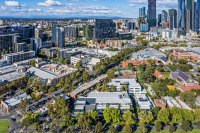
The plan for tackling Australia’s housing affordability crisis looks great on paper, with a target of 1.2 million new homes across the country over five years from mid-2024. However, reality isn’t keeping up with ambition. Over the past decade, on average 150,000 to 200,000 dwellings have been completed per year, falling far short of the current target of 240,000 new homes per year.
Facing ongoing population growth and housing shortages, how can the property sector get more high-quality but affordable residential options out of the ground quickly – especially for renters?
Approximately a third of Australians rent rather than own a home. The trend towards rentals is increasing, influenced by factors such as high house prices, more single-person and single-parent households, and population growth in major cities. This is creating a new opportunity for investors and developers in the form of the ‘build to rent’ (BTR) asset class, which is well established in the UK, US and a number of European countries.
Rapid growth of the BTR ecosystem around our biggest cities could be a very powerful lever for alleviating pressure in the housing sector, boosting rental availability for Australians desperately needing more housing options.
Still early days for BTR in Australia
Although BTR in Australia has passed its infancy stage, the market has a way to go before it can be considered mature. Uncertainty around housing policies, taxes and charges remain a barrier for developers and investors. International investors are deterred by current tax regimes and are looking at additional risk premiums to reduce their exposure, which makes it harder for the numbers to stack up.
We have, however, seen a lot of activity in the BTR space over recent months. Melbourne is leading the charge, with recent policy updates and rezonings across many suburbs. Sydney is catching up, with a $1.5 billion precinct proposed for Marrickville, and multiple high-rise blocks promising more affordable prices in inner suburbs. Brisbane has several projects underway and other states are also encouraging BTR inflow through tax concessions and similar initiatives.
As Australia navigates the investment challenges, local contractors are under pressure due to BTR project uncertainty or delay. Some BTR projects have encountered delays or undergone significant changes – with a lot of rework needed. However, as the market becomes increasingly familiar with BTR and some stable trends are emerging, the contractor market is gaining more confidence in this space.
In some ways, BTR is an easier product to build, with greater uniformity and fewer purchaser-led changes to design, making the process easier for the contractor to manage and reducing risk on the contractor’s side.
‘Copy and paste’ approaches can unlock efficiencies
Rolling out more BTR developments quickly, and at the right cost, is going to require efficiencies – and there’s nothing more efficient than standardisation and replication. That doesn’t mean there’s no room for creativity. In fact, innovative thinking will be crucial for creating the right ‘templates’ to follow. To create an affordable product that delivers value over many decades, developers will need to work to understand the needs, expectations and lifestyle preferences of their potential tenants and embed these insights into the design.
Significant cost savings and time efficiencies can be unlocked through standardisation opportunities in the planning, design, procurement and construction phases (including the possibility of automation and prefabrication). These efficiencies can be maximised by investing early in digital tools such as BIM and digital twins, which can deliver significant benefits by reducing errors, delays and costs during design and construction, as well as revolutionising facilities management.
Of course, given the newness of Australia’s BTR scene, many developers are still working on their first BTR projects, so it will take time to land the right approaches to standardisation – but we expect to see more uniformity emerge in design and construction methods. There is also opportunity to explore the potential for efficiencies in procurement, such as panel arrangements to streamline the roll out of projects and increase consistency.
Playing the long game
Attracting and retaining good tenants will be key to a stable long-term revenue stream. Crucial inputs to maintaining high occupancy and tenant satisfaction are how well the facility is managed and maintained.
With facilities management a major ongoing cost, any efficiencies here will add up over the long term, and the opex savings could far outweigh the potential extra upfront capex investment. To drive operational costs down without compromising quality, developers should consider opportunities for lower maintenance and higher durability in every decision. Smart technologies may be well worth the extra upfront investment, especially if they reduce human time, which is often the greatest cost in facilities management.
Ultimately, good decisions about the life of a building are grounded in reliable information and a long-term perspective. Comprehensive whole-of-life cost management will reveal the total costs associated with the asset over its entire lifecycle. Any options can be analysed in terms of capital costs as well as lifecycle costs for the same systems or products, informing annual cost savings, net savings over the lifecycle, and payback periods.
A new chapter in Australia’s housing journey
While the BTR market is still navigating some early ups and downs and there is still some hesitancy from the investor side, green shoots are emerging. Signs of streamlined processes and greater stability will give the sector confidence and much-needed momentum.
The BTR market could be a game-changer in the housing crisis. With efficient design and construction and high-quality property management, there’s every reason to expect to see its full potential unlocked. We’re looking forward to seeing this new asset class alleviating the current ‘rental squeeze’ and delivering quality, sustainable housing for the growing number of Australian tenants.
About the authors
Ian Menzies is a National Director at WT. Ian brings over 30 years of experience in quantity surveying and cost management spanning residential, retail, hotel, education, and mixed-use developments. As part of WT’s National Leadership Team, Ian plays a key role driving strategic initiatives to enable business growth and create enhanced value for clients.
Kate Kirgizova is an Associate Director at WT. She brings extensive experience in strategic project cost management, contract and procurement strategies spanning a wide range of projects and sectors. Having worked across a variety of markets in Australia and internationally, Kate has seen first-hand the challenges of the housing markets across the globe and opportunities for cost efficient delivery in the housing sector.
Brendan Browne is a State Director at WT. He has over 15 years of experience in quantity surveying and cost management in Australia and Ireland, working across a range of sectors spanning commercial, education, retail and residential. As WT’s Residential Sector Lead for NSW, Brendan focus on strategic initiatives to create value for clients operating in this market, bringing a wealth of experience in BTS and BTR.






